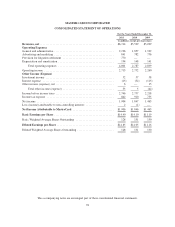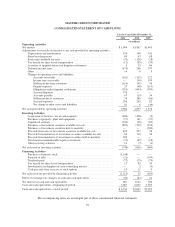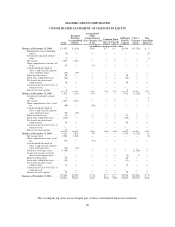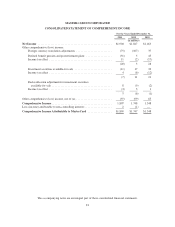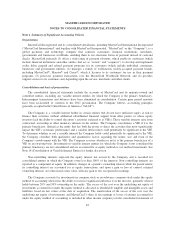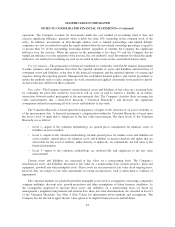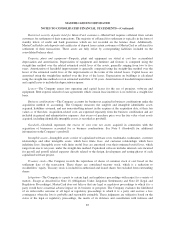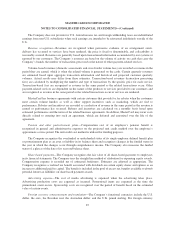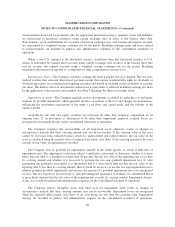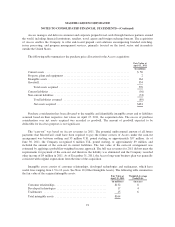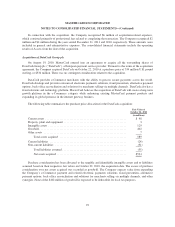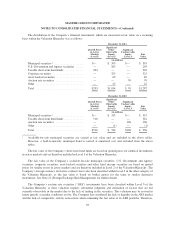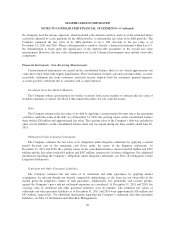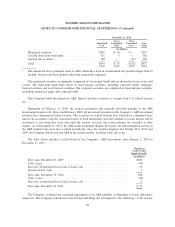MasterCard 2011 Annual Report Download - page 92
Download and view the complete annual report
Please find page 92 of the 2011 MasterCard annual report below. You can navigate through the pages in the report by either clicking on the pages listed below, or by using the keyword search tool below to find specific information within the annual report.MASTERCARD INCORPORATED
NOTES TO CONSOLIDATED FINANCIAL STATEMENTS—(Continued)
remeasurement from each local currency into the appropriate functional currency, monetary assets and liabilities
are remeasured to functional currencies using current exchange rates in effect at the balance sheet date.
Non-monetary assets and liabilities are recorded at historical exchange rates, and revenue and expense accounts
are remeasured at a weighted average exchange rate for the period. Resulting exchange gains and losses related
to remeasurement are included in general and administrative expenses in the consolidated statement of
operations.
Where a non-U.S. currency is the functional currency, translation from that functional currency to U.S.
dollars is performed for balance sheet accounts using current exchange rates in effect at the balance sheet date
and for revenue and expense accounts using a weighted average exchange rate for the period. Resulting
translation adjustments are reported as a component of other comprehensive income (loss).
Earnings per share—The Company calculates earnings per share using the two-class method. The two-class
method clarifies that unvested share-based payment awards that contain nonforfeitable rights to dividends or
dividend equivalents are considered participating securities and should be included in the calculation of earnings
per share. The dilutive effect of incremental common stock equivalents is reflected in diluted earnings per share
by the application of the treasury stock method. See Note 3 (Earnings Per Share) for further detail.
Impairment of assets—The Company regularly reviews investments accounted for under the cost and equity
methods for possible impairment, which generally involves an analysis of the facts and changes in circumstances
influencing the investment, expectations of the entity’s cash flows and capital needs, and the viability of the
business model.
Available-for-sale debt and equity securities are evaluated for other than temporary impairment on an
ongoing basis. If an investment is determined to be other than temporarily impaired, realized losses are
recognized in investment income on the consolidated statements of operations.
The Company evaluates the recoverability of all long-lived assets whenever events or changes in
circumstances indicate that their carrying amount may not be recoverable. If the carrying value of the asset
cannot be recovered from estimated future cash flows, undiscounted and without interest, the fair value of the
asset is calculated using the present value of estimated net future cash flows. If the carrying amount of the asset
exceeds its fair value, an impairment is recorded.
The Company tests its goodwill for impairment annually in the fourth quarter, or sooner if indicators of
impairment exist. The impairment evaluation utilizes a qualitative assessment to determine whether it is more
likely than not (that is, a likelihood of more than 50 percent) that the fair value of the reporting unit is less than
its carrying amount and whether it is necessary to perform the two-step goodwill impairment test. If, after
performing the qualitative assessment, it is determined that it is more likely than not that the fair value of the
reporting unit is less than its carrying amount, then it would be necessary to use the two-step impairment test to
identify potential goodwill impairment and measure the amount of a goodwill impairment loss to be recognized
(if any). The two-step test is not necessary if, after performing the qualitative assessment, it is determined that it
is more likely than not that the fair value of the reporting unit exceeds its carrying amount. Impairment charges,
if any, are recorded in general and administrative expenses on the consolidated statement of operations.
The Company reviews intangible assets with finite lives for impairment when events or changes in
circumstances indicate that their carrying amounts may not be recoverable. Impairment losses are recognized
when the expected undiscounted cash flows of an asset group are less than the carrying value. Impairment
charges are recorded in general and administrative expense on the consolidated statement of operations.
88


